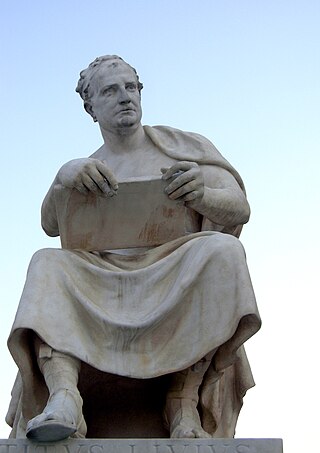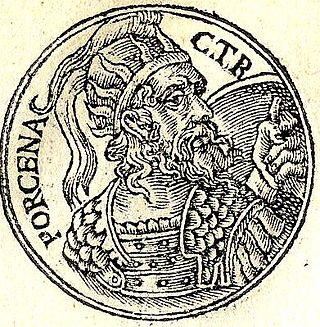Related Research Articles

Lucius Tarquinius Superbus was the legendary seventh and final king of Rome, reigning 25 years until the popular uprising that led to the establishment of the Roman Republic. He is commonly known as Tarquin the Proud, from his cognomen Superbus.

Titus Livius, known in English as Livy, was a Roman historian. He wrote a monumental history of Rome and the Roman people, titled Ab Urbe Condita, ''From the Founding of the City'', covering the period from the earliest legends of Rome before the traditional founding in 753 BC through the reign of Augustus in Livy's own lifetime. He was on good terms with members of the Julio-Claudian dynasty and was a friend of Augustus, whose young grandnephew, the future emperor Claudius, he encouraged to take up the writing of history.

The Bacchanalia were unofficial, privately funded popular Roman festivals of Bacchus, based on various ecstatic elements of the Greek Dionysia. They were almost certainly associated with Rome's native cult of Liber, and probably arrived in Rome itself around 200 BC. Like all mystery religions of the ancient world, very little is known of their rites. They seem to have been popular and well-organised throughout the central and southern Italian peninsula.

RheaSilvia, also known as Ilia, was the mythical mother of the twins Romulus and Remus, who founded the city of Rome. This event was portrayed numerous times in Roman art Her story is told in the first book of Ab Urbe Condita Libri of Livy and in Cassius Dio's Roman History. The Legend of Rhea Silvia recounts how she was raped by Mars while she was a Vestal Virgin, resulting in the twins, as mentioned in the Aeneid and the works of Ovid.

The Hernici were an Italic tribe of ancient Italy, whose territory was in Latium between the Fucine Lake and the Sacco River (Trerus), bounded by the Volsci on the south, and by the Aequi and the Marsi on the north.

The Aequi were an Italic tribe on a stretch of the Apennine Mountains to the east of Latium in central Italy who appear in the early history of ancient Rome. After a long struggle for independence from Rome, they were defeated and substantial Roman colonies were placed on their soil. Only two inscriptions believed to be in the Aequian language remain. No more can be deduced than that the language was Italic. Otherwise, the inscriptions from the region are those of the Latin-speaking colonists in Latin. The colonial exonym documented in these inscriptions is Aequi and also Aequicoli. The manuscript variants of the classical authors present Equic-, Aequic-, Aequac-. If the form without the -coli is taken as an original, it may well also be the endonym, but to date further evidence is lacking.
This is a timeline of Roman history, comprising important legal and territorial changes and political events in the Roman Kingdom and Republic and the Roman and Byzantine Empires. To read about the background of these events, see Ancient Rome and History of the Byzantine Empire.

The Battle of Lake Regillus was a legendary Roman victory over the Latin League shortly after the establishment of the Roman Republic and as part of a wider Latin War. The Latins were led by an elderly Lucius Tarquinius Superbus, the seventh and last King of Rome, who had been expelled in 509 BC, and his son-in-law, Octavius Mamilius, the dictator of Tusculum. The battle marked the final attempt of the Tarquins to reclaim their throne. According to legend, Castor and Pollux fought on the side of the Romans.

Lars Porsena was an Etruscan king (lar) known for his war against the city of Rome. He ruled over the city of Clusium. There are no established dates for his rule, but Roman sources often place the war at around 508 BC.

Valerius Antias was an ancient Roman annalist whom Livy mentions as a source. No complete works of his survive but from the sixty-five fragments said to be his in the works of other authors it has been deduced that he wrote a chronicle of ancient Rome in at least seventy-five books. The latest dateable event in the fragments is mention of the heirs of the orator, Lucius Licinius Crassus, who died in 91 BC. Of the seventy references to Antias in classical literature sixty-one mention him as an authority on Roman legendary history.

The work called Ab urbe condita, sometimes referred to as Ab urbe condita libri, is a monumental history of ancient Rome, written in Latin between 27 and 9 BC by Livy, a Roman historian. The work covers the period from the legends concerning the arrival of Aeneas and the refugees from the fall of Troy, to the city's founding in 753 BC, the expulsion of the Kings in 509 BC, and down to Livy's own time, during the reign of the emperor Augustus. The last event covered by Livy is the death of Drusus in 9 BC. 35 of 142 books, about a quarter of the work, are still extant. The surviving books deal with the events down to 293 BC, and from 219 to 166 BC.
The Rutuli or Rutulians were an ancient people in Italy. The Rutuli were located in a territory whose capital was the ancient town of Ardea, located about 35 km southeast of Rome.
The Roman–Etruscan Wars, also known as the Etruscan Wars or the Etruscan–Roman Wars, were a series of wars fought between ancient Rome and the Etruscans. Information about many of the wars is limited, particularly those in the early parts of Rome's history, and in large part is known from ancient texts alone. The conquest of Etruria was completed in 265–264 BC.
The Roman conquest of the Hernici, an ancient Italic people, took place during the 4th century BC. For most of the 5th century BC, the Roman Republic had been allied with the other Latin states and the Hernici to successfully fend off the Aequi and the Volsci. In the early 4th century BC, this alliance fell apart. A war fought between Rome and the Hernici in the years 366–358 BC ended in Roman victory and the submission of the Hernici. Rome also defeated a rebellion by some Hernician cities in 307–306 BC. The rebellious Hernici were incorporated directly into the Roman Republic, while those who had stayed loyal retained their autonomy and nominal independence. In the course of the following century, the Hernici became indistinguishable from their Latin and Roman neighbours and disappeared as a separate people.
Casystes or Kasystes was a port town of ancient Ionia, near Erythrae. Strabo, whose description proceeds from south to north, after describing Teos, says, "before you come to Erythrae, first is Erae, a small city of the Teians, then Corycus, a lofty mountain, and a harbour under it, Casystes; and another harbour called Erythras." It is probably the Cyssus of Livy, the port to which the fleet of Antiochus III sailed (191 BCE) before the naval engagement in which the king was defeated by Eumenes II and the Romans.
Nephelis was a small town of ancient Cilicia, situated, according to Ptolemy, between Antioch and Anemurium; but if, as some suppose, it be the same place as the Zephelium or Zephelion (Ζεφέλιον) mentioned in the Stadiasmus Maris Magni, it ought to be looked for between Selinus and Celenderis. Near the place was a promontory of the same name, where, according to Livy, the fleet of Antiochus the Great was stationed, when, after reducing the towns of Cilicia as far as Selinus, he was engaged in the siege of Coracesium, and where he received the ambassadors of the Rhodians.
Beudos, also known as Palaion Beudos or Beudos Vetus, was a town of ancient Phrygia, inhabited during Hellenistic, Roman, and Byzantine times. Livy, when describing the march of Manlius, places five Roman miles from Synnada, and between Synnada and Anabura.
References
- ↑ Livy. Ab urbe condita Libri [History of Rome]. Vol. 24.41.
 This article incorporates text from a publication now in the public domain : Smith, William, ed. (1854–1857). "Acra Leuce". Dictionary of Greek and Roman Geography . London: John Murray.
This article incorporates text from a publication now in the public domain : Smith, William, ed. (1854–1857). "Acra Leuce". Dictionary of Greek and Roman Geography . London: John Murray.